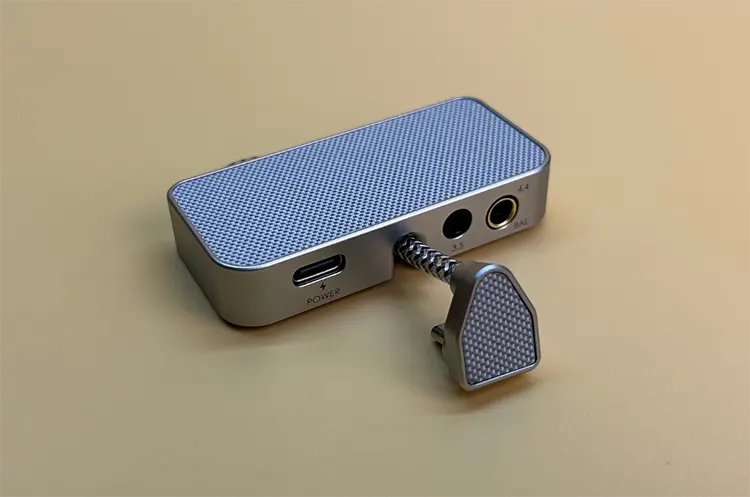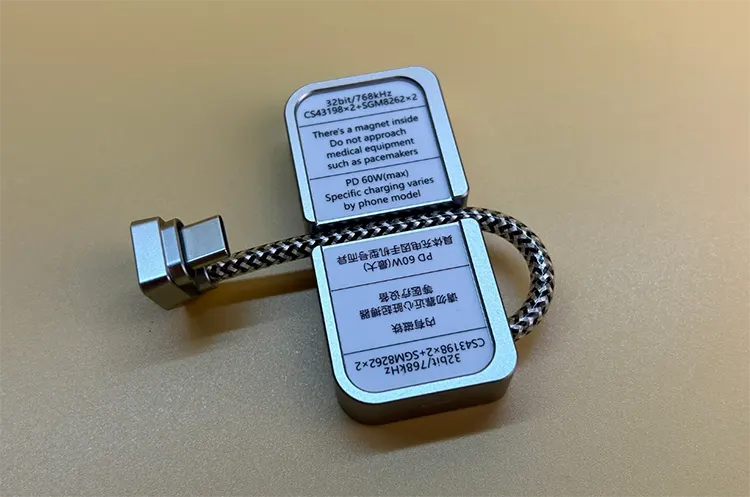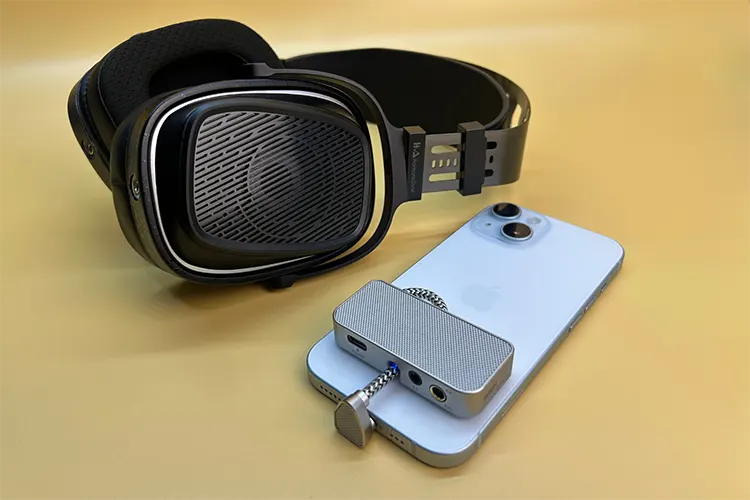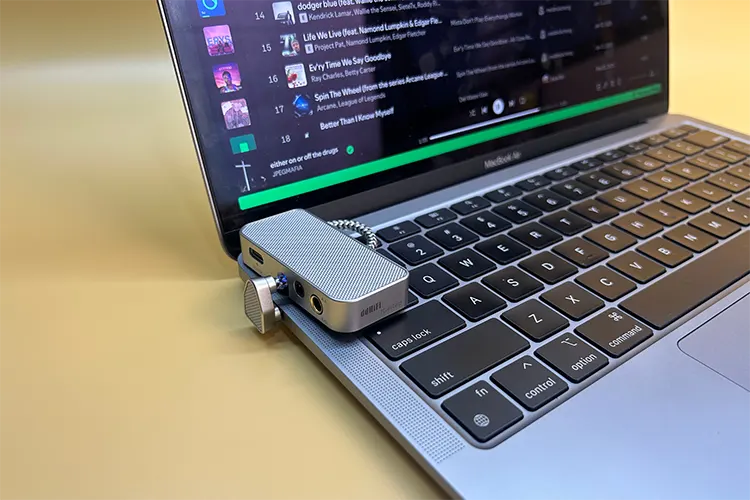Blog
ddHiFi TC44Grip Review — Headfonics

Meldrick reviews the ddHiFi TC44Grip, an innovative dual CS43198-capable, 330mW dongle DAC that attaches to the back of a smartphone or iPhone.
Disclaimer: This sample was sent to me in exchange for my honest opinion. Headfonics is an independent website with no affiliate links. I thank ddHiFi for their support.
You can read about previous ddHiFi products previously reviewed on Headfonics here.
This article follows our latest scoring guidelines, which you can read here.
After reviewing the TC44Pro M3 and TC44Pro E3, I really thought ddHiFi couldn’t surprise me. Today, I’m happy to say they’ve proved me wrong.
On paper, the TC44Pro Grip may just seem like any other dongle with enough power to slot in between the TC44Pro M3 and E3, but looking at the dongle’s design shows otherwise.
Purposely designed to be a daily companion to smartphones, the TC44Grip’s claim to fame is its “Attraction Pad” system, letting users securely mount and dismount the dongle from their phones with very little fuss.
It’s been a while since the prospect of reviewing a dongle has excited me this much. But to see if the TC44Grip lives up to its potential and how it competes against the iFi audio GO Link Max and 7Hz’s Artemis39, read my full review below.


Features
The TC44Grip sets itself apart from the rest of ddHiFi’s dongle lineup with a distinct focus on on-the-go usability. Chief among these is the magnetic attachment system, which allows the unit to clip securely onto the back of a phone or DAP.
It’s a simple yet practical feature that keeps the DAC firmly in place, reducing strain on the USB-C port and eliminating the awkward dangling effect common with most dongles.
ddHiFi also designed a recessed channel into the shell that guides the cable neatly through, further tidying up the setup for daily use.
Charging concerns are cleverly addressed with its support for PD fast charging up to 60W, meaning users can keep their source topped up while listening.
Power delivery is respectable, offering up to 330mW from its 4.4mm balanced output and 80mW from the single-ended jack, enough to comfortably drive most IEMs and a fair number of more efficient headphones.


Design
The TC44Grip continues ddHiFi’s tradition of using an all-aluminum chassis with a precision-machined, raw anodized finish.
The result is a shell that feels both sturdy and refined in hand. Over the course of testing, the finish proved impressively durable, resisting fingerprints and micro-scratches far better than most dongles in its class.
The front panel adopts a textured surface reminiscent of the 1800D carbon fiber trim first seen on the original TC44Pro, though ddHiFi has not confirmed if the same material is used here.
Around the perimeter, the classic anodized aluminum finish is complemented by a stylized ddHiFi and TC44Grip logo etched neatly on the right side.
Most of the functional elements are concentrated along the bottom edge. The far left houses a USB-C port for PD pass-through charging, followed by a recessed channel designed to route the fixed USB-C cable cleanly across the unit.
Next to it are the 3.5mm single-ended and 4.4mm balanced outputs, spaced comfortably to avoid crowding.
Up top, the design is kept minimal aside from the permanently attached high-quality cable, similar in style to what ddHiFi used on the TC44Pro E2.
In practice, this cable does a good job of keeping the dongle in place during use, preventing unnecessary strain or movement. Flipping the unit over reveals the full length of the recessed channel, which also houses the status LED.
The indicator presents itself as a subtle underglow, projecting gently towards the bottom of the dongle and the source device, remaining visible without being distracting.
The rear also neatly lists key specifications and usage instructions, a small but useful detail that makes the TC44Grip especially user-friendly straight out of the box.


Controls
The ddHiFi TC44Grip keeps things minimal with a no-frills control scheme. It is a true plug-and-play device that works straight out of the box without drivers or companion software.
The trade-off, however, is the lack of onboard volume and gain controls, leaving all adjustments to the connected source, be it a phone, tablet, or computer.
Day-to-day use with a smartphone, however, is where the TC44Grip shines. Following ddHiFi’s recommendation, I placed the magnetic pad about 10mm above the bottom of my phone case, where it adhered securely.
The stiff attached USB-C cable feeds neatly through the channel at the rear of the dongle before the angled connector slots firmly into the phone, locking the unit onto the pad with surprising stability.
Rarely did it come loose with the TC44Grip feeling more like an extension of my phone rather than the typical dangling dongle experience.
This made holding and interacting with my phone far more natural, eliminating the small juggling act I usually go through to keep a dongle out of the way.
While not the smallest DAC, it still slid in and out of my jeans pocket without fuss, with the magnetic mount making it easier to manage than most.
Using the TC44Grip with a laptop or desktop was less ideal. The fixed 180-degree USB-C jack and stiff cable meant the dongle often floated awkwardly above the port instead of lying flat, putting unnecessary tension on the connection. In those cases, I still preferred more conventional designs like the TC44Pro E3.
In my work setup with a laptop riser, the TC44Grip could be positioned so that its rear panel rested flush against the underside of the machine, creating a surprisingly tidy orientation. Still, this felt more like a niche workaround than a core feature.


I/O
The ddHiFi TC44Grip takes an input-lite but high-impact approach to I/O. Its primary input is the permanently attached cable that terminates in a 180-degree USB-C male plug for data transfer.
It also has a USB-C female port that acts as a pass-through PD charging interface, supporting up to 60 W, so you can keep your phone or tablet powered while listening.
On the output side, the TC44Grip provides both a 3.5 mm single-ended jack and a 4.4 mm balanced jack, the former rated at 80 mW into 32 Ω and the latter at 330 mW, covering both everyday IEMs and more demanding portable headphones.
An integrated LED status light also shifts color depending on the playback format, offering quick visual feedback without being obtrusive.
Since I usually listen to music on my phone while on the go, the PD pass-through was not something I regularly used during my portable testing. However, I did use PD charging quite a bit in the office with the TC44Pro plugged into my work laptop.
One of the main drawbacks of this design, however, is its incompatibility with USB-C adapters. In my testing, the TC44Grip did not function with the USB-C to Lightning and USB-C to USB-A adapters that worked seamlessly with ddHiFi’s other dongles, such as the TC44Pro E3.
While I have not confirmed this with ddHiFi directly, it may be due to the PD implementation on the Grip not playing well with the more basic USB-C protocols used by these adapters. Unfortunately, this limits its versatility.
I was unable to pair it with my daily driver iPhone 14, forcing me to conduct most of my listening tests on an Android phone with native USB-C.


Packaging & Accessories
The TC44Grip ships in a clean, minimalist box that includes three magnetic attraction pads (one aluminum alloy, two leather style), two decorative pads (black and khaki) for aesthetic preference, and a quick start guide with documentation
The inclusion of both functional attraction pads and decorative options shows ddHiFi’s intent to make the dongle feel like part of your phone, not just another add-on. The aluminum pad offers a stronger magnetic grip for frequent use, while the leather pads provide a lighter touch.
The decorative pads let you customize the look without interfering with function. While the package is not overloaded with extras, it delivers exactly what is needed to get started, and the choice of pads adds meaningful flexibility from day one.
Sound Impressions
All testing and comparisons were completed using 3 pairs of IEMS; namely, the MOONDROP Blessing 3, Yanyin Canon II, and the Kiwi Ears KE4, and 2 pairs of full-sized headphones, the Sennheiser HD 600 and the HarmonicDyne BAROQUE.
Bass
The bass performance of the TC44Grip leaves much to be desired. Sub-bass notes carry little impact or texture, lacking the chest-shaking sensation that many mixes and tracks are expected to deliver.
In some cases, a dongle can compensate for low sub-bass quantity with tight and well-defined presentation, but the TC44Grip struggles here as well.
Bass hits often sound one-dimensional, whether they come from digital drum machines or acoustic recordings of kick drums, and individual sub-bass notes can blur together, making it difficult to distinguish one hit from the next.
Mid-bass response does not fare much better, with a noticeable absence of body or warmth that robs lower frequency synths and bass guitars of their weight.
Funk tracks and more atmospheric arrangements, in particular, feel thinner and lose a sense of scale compared to what is achievable with more neutrally tuned or warmer dongles.
Even when expectations are adjusted toward a clean, neutral presentation, the TC44Grip’s low end can still feel lacking, though this restraint does give the midrange more space to shine.


Mids
The midrange of the TC44Grip benefits from its leaner bass tuning, which clears out any sense of muddiness or bloat and allows instruments and vocals to come through with greater precision.
String instruments are reproduced with pleasing harmonics and a natural sense of decay, giving acoustic passages an authentic timbre.
Vocals are also well-handled, with solid emphasis that highlights detail and texture. Female vocals and higher-pitched male voices stand out especially, presented with good micro-detail and a sense of intimacy that feels engaging.
Electric guitars likewise come across with satisfying energy and clarity, cutting cleanly through mixes without sounding overly sharp.
One of the strongest aspects of the TC44Grip is its handling of the upper mids, where it delivers an airy, delicate presentation that avoids congestion and allows complex arrangements to breathe.
This lift in the upper midrange not only provides openness and refinement but also transitions smoothly into the treble.
Treble
The treble tuning of the TC44Grip leans toward the brighter side, carrying over the upper midrange emphasis and extending it into the top end.
Cymbals, hi-hats, and other percussive details come through with clarity and crispness, giving tracks a noticeable sense of sparkle and energy.
High-pitched synths are also brought forward with more intensity, which can add excitement and drive to electronic and pop music.
The elevated treble response contributes to a heightened sense of air and openness, creating a lighter presentation that balances out the leaner bass and gives the overall tuning a spacious character.
Where the TC44Grip shines most is in its ability to resolve micro detail. On stripped-back acoustic recordings that rely on delicate vocals, a single guitar, and subtle cymbal work, it delivers a clean, airy playback that feels refined and nuanced.
However, this same emphasis can work against it with poorly mastered or already bright material, where the added treble energy may lead to fatigue and occasional sibilance.


Staging and Dynamics
The TC44Grip delivers a solid staging performance that feels reasonably wide, though it does not quite encompass a full 360 degrees of directionality.
Within that space, instrument placement comes across as accurate, with moving sounds mapped clearly across the soundscape.
Separation is another strength, aided by the leaner sub-bass response and the added air brought by its elevated treble, which together create a presentation that feels open and uncluttered. This lighter balance, however, comes at a cost in terms of dynamics.
While the dongle handles shifts in volume and detail respectably, its delivery in bass-heavy tracks leaves something to be desired. Sub-bass hits and bass guitar lines in particular lack the note weight and impact that warmer or more neutrally tuned dongles tend to provide.
As a result, while the TC44Grip stages and separates well, its dynamic punch may feel underwhelming for.
Click on page 2 below for my recommended pairings and selected comparisons.













